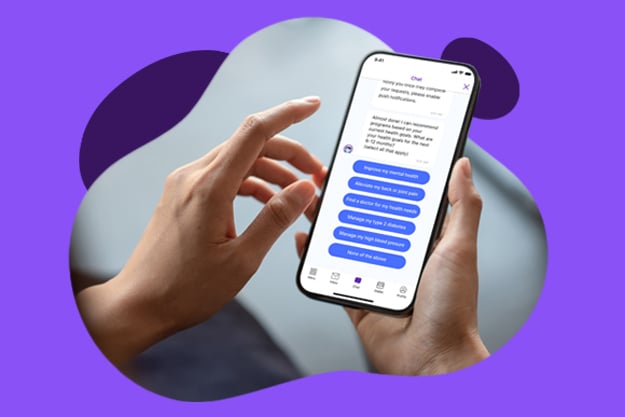How HealthJoy Recommends Facilities and Providers
At HealthJoy, we know better than most the impact of choosing the right medical facility or provider on healthcare outcomes and cost. Sure, choosing...
Connected Navigation Platform
Guiding to high-value care
Behavioral Health
Foster a mentally healthy workplace
EAP
Supporting holistic wellbeing
Virtual MSK Care
Reimagining musculoskeletal care
Virtual Primary Care
Powered by smart navigation
Surgery Centers of Excellence
Best-in-class surgical outcomes
Virtual Urgent Care
Immediate care, any hour of the day
Chronic Care
A new approach to chronic care
Integrations
Flexible to any strategy

In typical network agreements, discounts and billed charges are established in a largely arbitrary way. They don’t have much relationship to the actual cost of the procedure and can vary quite a bit by location, provider, and more.
Reference-based pricing (RBP) is a plan design strategy that helps self-insured companies control rapidly rising healthcare costs. In reference-based pricing, the employer sets a maximum amount they’ll reimburse for certain medical services. Any amount above that cap is the employee’s responsibility.
Reference-based pricing helps employers contain costs. Whereas traditional network agreements are based on a discount off of billed charges, reference-based pricing typically pays providers between 120% and 150% of Medicare reimbursement levels, which is considerably less than private insurance for the same services. Emergency procedures aren’t usually included in this pricing.
According to Mercer, RBP can result in up to 40% savings on overall medical spending, as well as a reduction in fraud, waste, abuse claims, and stop-loss premiums and claims.
Reference-based pricing works because it creates transparency. Understanding the costs and profits in healthcare services allows employers to identify lower-cost facilities and more accurately project their healthcare spending trends. While reference-based pricing can reduce costs for both employer and employee, it can also place an unacceptable burden on employees.
The impact of successfully implementing RBP can be dramatic. Benefits broker HUB International analyzed how RBP worked for 14 clients across the U.S. and found they saved as much as 46% on claims costs.
Between 2012 and 2017, RBP was able to lower $146.8 million in those HUB clients’ billed charges to $54.4 million in actual payments because of negotiated payment caps. HUB concluded that the same charges would have meant $74.7 million in charges for clients on a traditional PPO plan. In short, RBP saved HUB’s clients – most of whom had 150-200 employees- a combined $20.3 million in claims costs over five years.
We can find another example in California Public Employees’ Retirement System (CalPERS). Between 2011 and 2013, CalPERS saved $5.5 million by implementing a reference-based pricing health plan.
As the Employee Benefits Research Institute points out, savings for reference-based pricing happens when employees choose procedures at the reference price, providers reduce their prices to the approved amount, and employees pay any difference between the allowed amount and the actual amount.
It works best when employers guide employees to lower-cost options and incentivize the right choices. In almost every case, an outpatient facility will be a more cost-effective option than a hospital system. For example, for cataract-removal surgery, while only 6% of California hospital outpatient departments charged prices below the $2,000 contribution limit, 73% of ambulatory surgery centers charged below $2,000 (despite the fact that there was no discernible difference in quality).
In the first year, the average price paid by CalPERS for cataract removal decreased by 10.2 percent, and they saved an estimated $1.3 million over two years compared to what they would have spent without RBP.
Reference-based pricing falters when employees don’t get enough support.
Typically, a health plan provides a list of services, pricing structure, and providers who will accept the reference price for each service. But employees must be willing to do the research.
When they aren’t well-educated on their specific plan or guided to appropriate providers, the employee is left to pay the difference between the reimbursement maximum and the provider’s charge. This is called balance-billing, and trust us when we say: it has the potential to drive your employees mad.
It’s important to watch out for this landmine because even successful RBP plans can leave employees with more cost-sharing. For CalPERS patients, the average amount paid increased substantially after starting RBP. This increase was driven by those employees who continued to use hospital outpatient facilities.
In these cases, patient responsibility increased from $1,045 in 2011 to $4,918 in 2012 and to $5,681 in 2013 (claims data didn’t include whether the additional amount was paid, so those increases could be overstated).
In the HUB example, only 14% of the 24,000 claims were balance-billed to employees, and less than 1% of those claims progressed past a first appeal resolution.
Of course, companies on RBP don’t want to sacrifice quality for cost. For any health plan to work, employees will need to be able to locate high-quality providers. The good news is that cost and quality don’t seem to be correlated. The bad news is that finding a provider who balances the two can prove tricky.
Our highly trained team works hard to redirect our members to lower-cost, high-quality care whenever possible. Here’s how care redirection works.
To successfully implement RBP, employee education and assistance are essential. The challenge lies in explaining why employees should adopt RBP and keeping it top-of-mind for every single healthcare decision throughout the year.
Unfortunately, our current healthcare system isn’t structured in a way that supports smart healthcare choices. Without assistance, patients can feel powerless about the costs of a single mistake. Online transparency tools are tough to navigate, and when the experience is separate from comparing providers and making appointments, it often proves too much to juggle. This type of confusion only generates more questions for HR.
The vast majority of employees won’t need a procedure in the week after their enrollment meeting. They’re far more likely to need high-cost care months after their initial meeting when they’ve forgotten about RBP completely. Without the tools to find high-value care, this is a recipe for disaster.
This challenging Catch 22 makes RBP daunting for many employers. When Lockton surveyed 1300 employers in 2019, only 2% responded they were currently using RBP, though 10% suggested they were considering it for the future.
A 2017 study published in the American Journal of Managed Care (AJMC) attempted to explain this low utilization trend. In interviews with employers, the authors uncovered the fear of “catastrophic” out-of-pocket costs as a key reason they didn’t want to initiate an RBP plan.
In their examination of reference-based pricing, the authors of the AJMC article concluded that employers need more support to make RBP work. Among their key solutions were improved decision support – i.e. help choosing the right facility or provider — and rewards programs.
To maximize success and minimize problems associated with RBP, you need a technology solution that will consistently educate, engage, and help employees make decisions.
That solution is HealthJoy. Our consumer experience eliminates the friction employers fear most when implementing RBP, and cuts down on employee confusion, as well.
Here’s how it works with HealthJoy.
Let’s say you have an employee named Carol who has been putting off her annual skin cancer screening because she’s not sure how to find a fair-priced provider who accepts the RBP pricing. She remembers HealthJoy can help her find a provider, so she logs into the app. She chats with our healthcare concierge (HCC) team, explaining she wants to find a provider and provides preferences for location, gender, and language.
Our HCC team gets to work! They have all the details on Carol’s RBP plan personally reach to find her the perfect, highly-rated provider who accepts the reference price.
Then, HealthJoy sends Carol a provider recommendation. We met all her preferences and she loves our suggestion. She then taps “Schedule an Appointment,” and HealthJoy sets the appointment on her behalf.
After her appointment, if Carol has a question about balance billing regarding this or any other visit, our talented Bill Review team is on hand to help her review charges and spot errors.
Best of all, throughout the entire process, she never has to check a list, compare prices, or contact HR for help.
In short, you can think of HealthJoy as the air traffic controller for any RBP plan, guiding employees to the right care at the right price, saving your HR team time, and helping you unlock all the savings of reference-based pricing.
Schedule a demo today to see how HealthJoy is building a better employee benefits experience.
This post was originally published in 2017 and updated in 2021.

At HealthJoy, we know better than most the impact of choosing the right medical facility or provider on healthcare outcomes and cost. Sure, choosing...

For an employee, navigating the healthcare system is just a series of difficult decisions. With unclear pricing and confusing deductibles, it’s...

This post provides an introduction to funding in a coalition, also known as captive-funding, and discusses best practices from leaders in the...